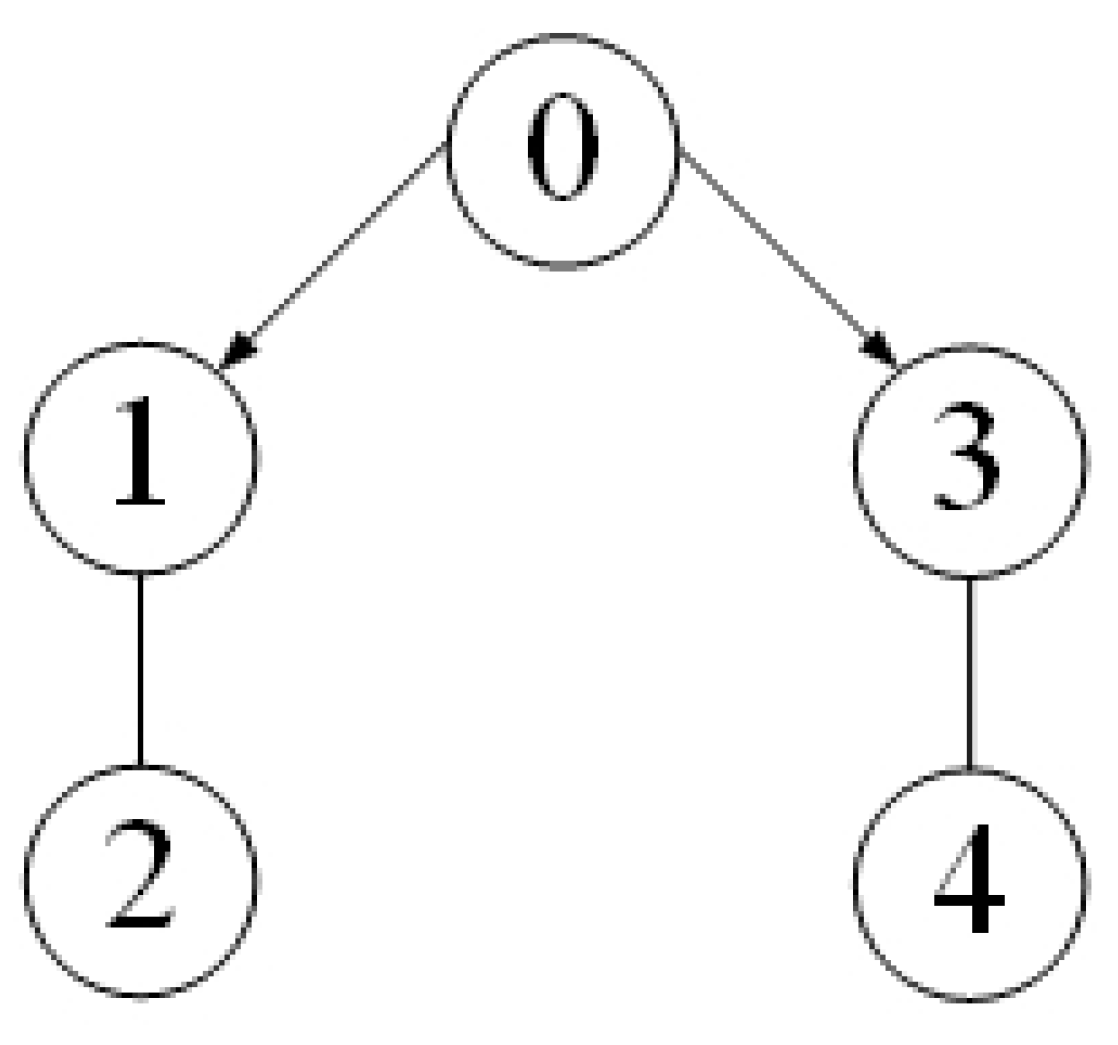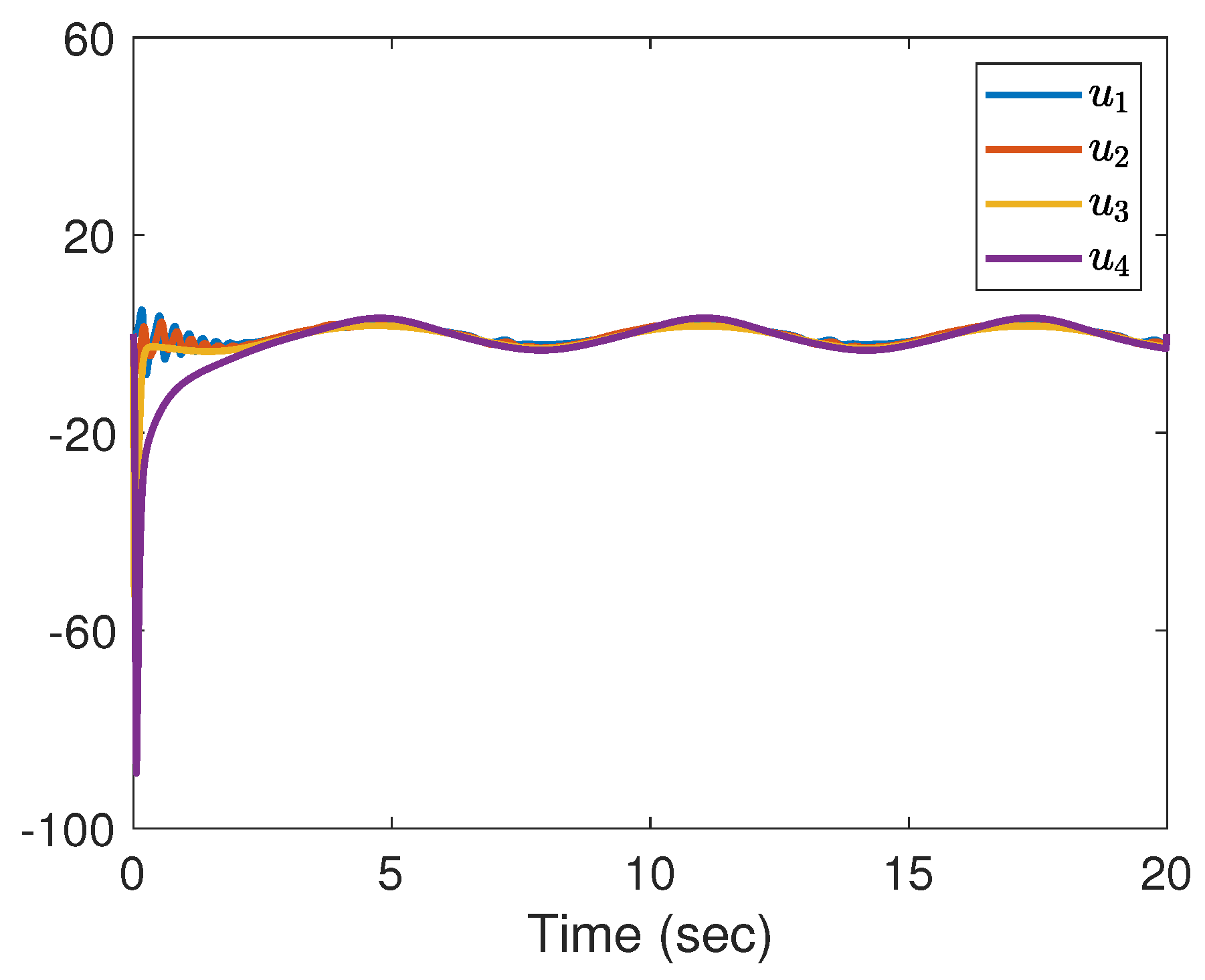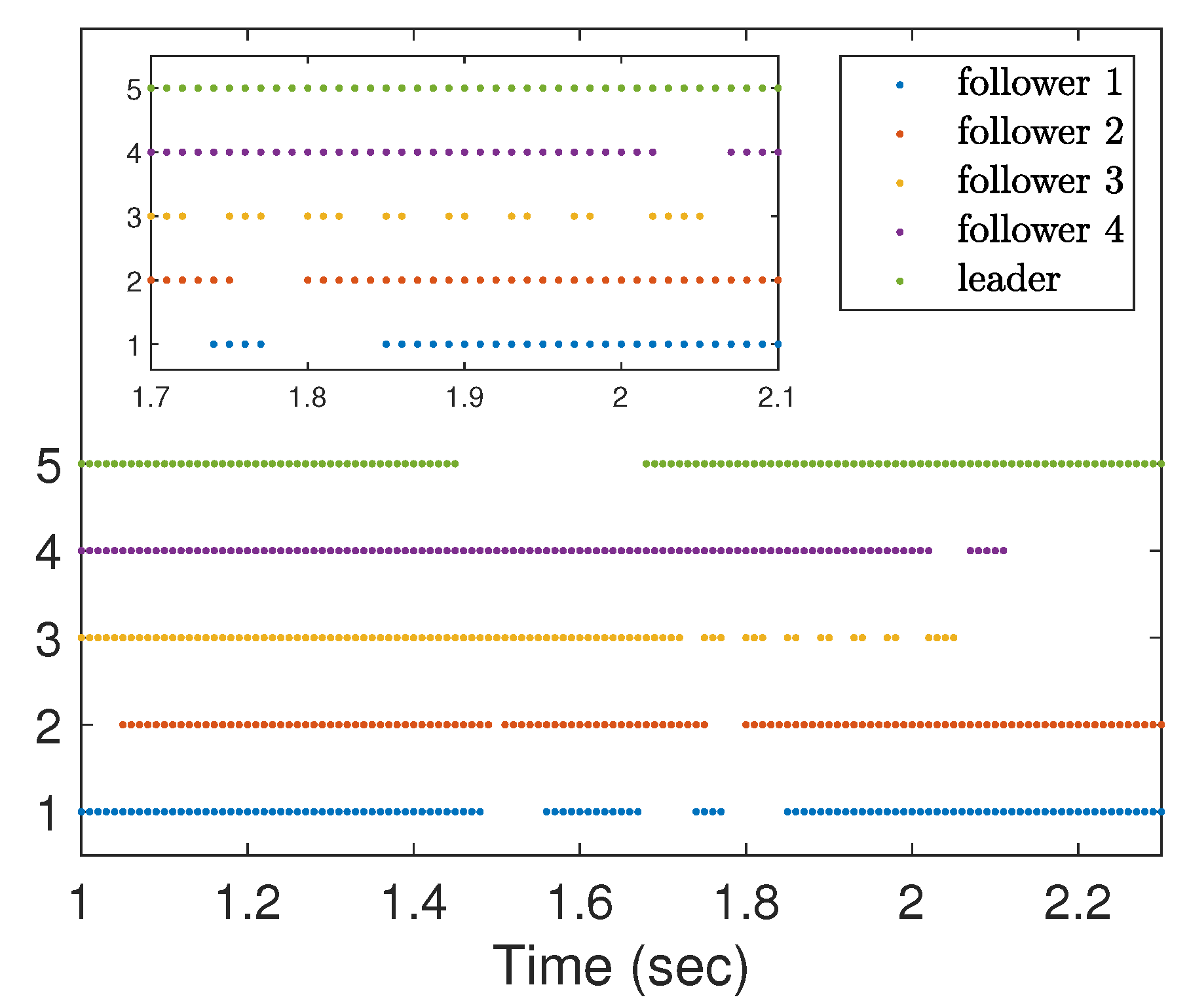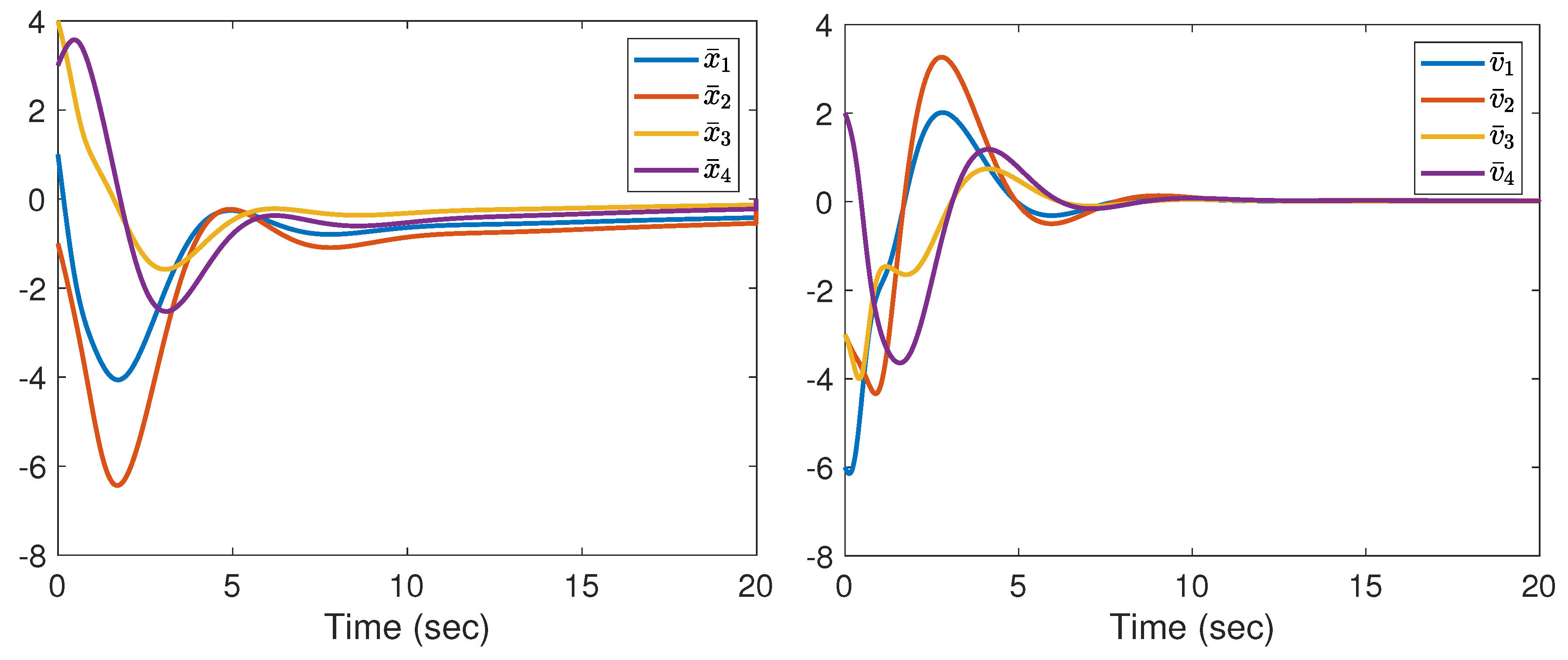Event-Triggered Bounded Consensus Tracking for Second-Order Nonlinear Multi-Agent Systems with Uncertainties
Abstract
:1. Introduction
2. Preliminaries
2.1. Graph Theory and Notation
| Q > 0 | the matrix Q is positive definite |
| the transposition of matrix Q | |
| the 2-norm of a matrix Q | |
| the largest eigenvalues of the matrix | |
| the smallest eigenvalues of the matrix | |
| an N-dimensional column vector with all entries being 1 | |
| the upper-right-hand derivative |
- (1)
- ,
- (2)
- 0, 0,
- (3)
- 0, 0.
2.2. Problem Statement
- (1)
- All signals that are caused by closed-loop systems are bounded globally uniformly on [0, );
- (2)
- There is no Zeno behavior;
- (3)
- The tracking errors, = −, = −, converge to a small adjustable bounded set.
3. Event-Based Distributed Adaptive Control Protocol Design
3.1. Triggering Mechanism
3.2. Adaptive Control Protocol
4. Main Results
5. Simulation of Nonlinear MASs with Uncertainties
6. Conclusions
Author Contributions
Funding
Data Availability Statement
Conflicts of Interest
References
- Ou, M.Y.; Du, H.B.; Li, S.H. Finite-time tracking control of multiple nonholonomic mobile robots. J. Frankl. Inst. 2015, 349, 2834–2860. [Google Scholar] [CrossRef]
- Schaub, H.; Vadali, S.R.; Junkins, J.L.; Alfriend, K.T. Spacecraft formation flying control using mean orbit elements. J. Astronaut. Sci. 2000, 48, 69–87. [Google Scholar] [CrossRef]
- Leonard, N.E.; Fiorelli, E. Virtual leader, artificial potentials and coordinated control of groups. In Proceeding of the 40th IEEE Conference on Decision and Control, Orlando, FL, USA, 4–7 December 2001; Volume 3, pp. 2968–2973. [Google Scholar]
- Fax, J.A.; Murray, R.M. Information flow and cooperative control of vehicle formations. IEEE Trans. Autom. Control. 2003, 49, 1465–1476. [Google Scholar] [CrossRef]
- Jadbabaie, A.; Lin, J.; Morse, A.S. Coordination of groups of mobile autonomous agents using nearest neighbor rules. IEEE Trans. Autom. Control. 2003, 48, 988–1001. [Google Scholar] [CrossRef]
- Cao, Y.C.; Ren, W.; Sorensen, N.; Larry, B.; Andrew, R.; Jonathan, K. Experiments in consensus-based distributed cooperative control of multiple mobile robots. In Proceedings of the 2007 International Conference on Mechatronics and Automation, Harbin, China, 5–8 August 2007; pp. 2819–2824. [Google Scholar]
- Dimarogonas, D.V.; Emilio, F.; Karl, H.J. Distributed event-triggered control for multi-agent systems. IEEE Trans. Autom. Control. 2012, 57, 1291–1297. [Google Scholar] [CrossRef]
- Cavone, G.; Dotoli, M.; Seatzu, C. Management of inermodal freight terminals by first-order hybrid petri nets. IEEE Robot. Autom. Lett. 2016, 1, 2–9. [Google Scholar] [CrossRef]
- Zhang, Z.Q.; Zhang, L.; Hao, F.; Wang, L. Periodic event-triggered consensus with quantization. IEEE Trans. Circuits Syst. Ii: Express Briefs 2015, 63, 406–410. [Google Scholar] [CrossRef]
- Li, H.Q.; Liao, X.F.; Huang, T.W.; Zhu, W. Event-triggering sampling based leader-following consensus in second-order multi-agent systems. IEEE Trans. Autom. Control. 2014, 60, 1998–2003. [Google Scholar] [CrossRef]
- Yang, D.P.; Ren, W.; Liu, X.D.; Chen, W.S. Decentralized event-triggered consensus for linear multi-agent systems under general directed graphs. Automatica 2016, 69, 242–249. [Google Scholar] [CrossRef]
- Li, H.Q.; Chen, G.; Xiao, L. Event-triggered nonlinear consensus in directed multi-agent systems with combinational state measurements. Int. J. Syst. Sci. 2016, 47, 3364–3377. [Google Scholar] [CrossRef]
- You, X.; Hua, C.C.; Guan, X.P. Self-triggered leader-following consensus for high-order nonlinear multiagent systems via dynamic output feedback control. IEEE Trans. Cybern. 2018, 49, 2002–2010. [Google Scholar] [CrossRef] [PubMed]
- Zhu, W.; Jiang, Z.P.; Feng, G. Event-based consensus of multi-agent systems with general linear models. Automatica 2014, 50, 552–558. [Google Scholar] [CrossRef]
- Cheng, Y.; Ugrinovskii, V. Event-triggered leader-following tracking control for multivariable multi-agent systems. Automatica 2016, 70, 204–210. [Google Scholar] [CrossRef]
- Cheng, B.; Li, Z.K. Fully distributed event-triggered protocols for linear multi-agent networks. IEEE Trans. Autom. Control. 2018, 64, 1655–1662. [Google Scholar] [CrossRef]
- Mishra, R.K.; Sinha, A. Event-triggered sliding mode based consensus tracking in second-order heterogeneous nonlinear multi-agent systems. Eur. J. Control. 2019, 45, 30–44. [Google Scholar] [CrossRef]
- Fu, Q.X.; Ren, C.E.; Zhang, J.; Shi, Z.P. Adaptive Event-Triggered Control for Nonlinear Multi-Agent Systems with State Time Delay and Unknown External Disturbance. In Proceedings of the 2021 IEEE International Conference on Systems, Man, and Cybernetics (SMC), Virtual, 17–20 October 2021; pp. 3095–3100. [Google Scholar]
- Tian, C.Y.; Liu, K.E.; Ji, Z.J. Adaptive event-triggered consensus of mutli-agent systems with general linear dynamics. Int. J. Syst. Sci. 2022, 53, 1744–1755. [Google Scholar] [CrossRef]
- Liu, K.Z.; Teel, A.R.; Sun, X.M.; Wang, X.F. Model-based dynamic event-triggered control for systems with uncertainty: A hybrid system approach. IEEE Trans. Autom. Control. 2021, 66, 444–451. [Google Scholar] [CrossRef]
- Zhao, M.; Peng, C.; He, W.L.; Song, Y. Event-triggered communication for leader-following consensus of second-order multiagent systems. IEEE Trans. Cybern. 2017, 48, 1888–1897. [Google Scholar] [CrossRef]
- Huang, N.; Duan, Z.S.; Wen, G.H.; Zhao, Y. Event-triggered consensus tracking of multi-agent systems with Lur’e nonlinear dynamics. Int. J. Control. 2016, 89, 1025–1037. [Google Scholar] [CrossRef]
- Deng, C.; Wen, C.C.; Huang, J.S.; Zhang, X.M.; Zou, Y. Distributed observer-based cooperative control approach for uncertain nonlinear MASs under event-triggered communication. IEEE Trans. Autom. Control. 2021, 67, 2669–2676. [Google Scholar] [CrossRef]
- Wang, W.; Wen, C.Y.; Huang, J.S.; Zhou, J. Adaptive consensus of uncertain nonlinear systems with event triggered communication and intermittent actuator faults. Automatica 2019, 111, 108667. [Google Scholar] [CrossRef]
- Long, J.; Wang, W.; Huang, J.S.; Wang, L. Event-triggered adaptive output consensus tracking control of uncertain nonlinear multi-agent systems. In Proceedings of the 2020 15th IEEE Conference on Industrial Electronics and Applications (ICIEA), Kristiansand, Norway, 9–13 November 2020; pp. 1312–1317. [Google Scholar]
- Shi, D.W.; Xue, J.; Zhao, L.X.; Wang, J.Z.; Huang, Y. Event-triggered active disturbance rejection control of dc torque motors. IEEE Trans. Mechatronics 2017, 22, 2277–2287. [Google Scholar] [CrossRef]
- Niu, X.L.; Liu, Y.G.; Man, Y.C. Adaptive leader-following consensus for uncertain nonlinear multi-agent systems. Asian J. Control 2017, 19, 1189–1196. [Google Scholar]
- Hartman, P. Ordinary Differential Equations; Society for Industrial and Applied Mathematics: Philadelphia, PA, USA, 2002. [Google Scholar]
- Mechali, M.; Xu, L.M.; Huang, Y.; Shi, M.J.; Xie, X.M. Observer-based fixed-time continuous nonsingular terminal sliding mode control of quadrotor aircraft under uncertainties and disturbances for robust trajectory tracking: Theory and experiment. Control Eng. Pract. 2021, 111, 104806. [Google Scholar] [CrossRef]





| Work | Control Coefficient | Lipschitz Constant | External Disturbance | Leader Input |
|---|---|---|---|---|
| [21] | No | Known | No | Known |
| [22] | No | Unknown | No | Zero |
| [22] | No | Unknown | No | Zero |
| [23] | Yes | Unknown | No | Unknown |
| this paper | Yes | Unknown | Yes | Unknown |
| Protocol | ACT | IAU |
|---|---|---|
| CWT | 5 s | 205.4932 |
| CWNT | 8.5 s | 622.5718 |
Disclaimer/Publisher’s Note: The statements, opinions and data contained in all publications are solely those of the individual author(s) and contributor(s) and not of MDPI and/or the editor(s). MDPI and/or the editor(s) disclaim responsibility for any injury to people or property resulting from any ideas, methods, instructions or products referred to in the content. |
© 2023 by the authors. Licensee MDPI, Basel, Switzerland. This article is an open access article distributed under the terms and conditions of the Creative Commons Attribution (CC BY) license (https://creativecommons.org/licenses/by/4.0/).
Share and Cite
Ma, Y.; Gu, C.; Liu, Y.; Yu, L.; Tang, W. Event-Triggered Bounded Consensus Tracking for Second-Order Nonlinear Multi-Agent Systems with Uncertainties. Entropy 2023, 25, 1335. https://doi.org/10.3390/e25091335
Ma Y, Gu C, Liu Y, Yu L, Tang W. Event-Triggered Bounded Consensus Tracking for Second-Order Nonlinear Multi-Agent Systems with Uncertainties. Entropy. 2023; 25(9):1335. https://doi.org/10.3390/e25091335
Chicago/Turabian StyleMa, Ying, Chan Gu, Yungang Liu, Linzhen Yu, and Wei Tang. 2023. "Event-Triggered Bounded Consensus Tracking for Second-Order Nonlinear Multi-Agent Systems with Uncertainties" Entropy 25, no. 9: 1335. https://doi.org/10.3390/e25091335
APA StyleMa, Y., Gu, C., Liu, Y., Yu, L., & Tang, W. (2023). Event-Triggered Bounded Consensus Tracking for Second-Order Nonlinear Multi-Agent Systems with Uncertainties. Entropy, 25(9), 1335. https://doi.org/10.3390/e25091335





